Best Automatic Watches [Key Factors To Consider]
Note: This page contains affiliate links.
As an Amazon Associate, I earn from qualifying purchases when you click on the link, but you are not charged extra.
Automatic watches are a popular choice for enthusiasts and collectors, offering a blend of craftsmanship, style, and functionality. Powered by the natural movement of the wearer, these timepieces do not require batteries, making them a more eco-friendly and long-lasting option compared to quartz watches. From intricate mechanical engineering to elegant design features, automatic watches stand out as a symbol of precision and timeless luxury. Whether you’re looking for your first automatic watch or adding to an existing collection, understanding key aspects such as movement type, materials, and brand reputation is essential for making an informed decision.
In this buyer’s guide, we’ll explore the factors to consider when choosing an automatic watch. We’ll discuss different movement types like Swiss or Japanese, case materials such as stainless steel or titanium, and the importance of water resistance and other special features. We’ll also provide insights into reputable brands that offer exceptional craftsmanship at various price points, helping you find the perfect automatic watch that suits both your personal style and functional needs.
Best Automatic Watches: Quick Comparison Table
| Features | Pros | Cons | |
|---|---|---|---|
Blue Dial Skeleton Tourbillon Dress Watch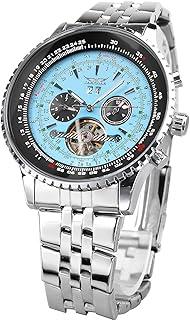 Check Price Check Price |
|
|
|
Stainless Steel Luminous Business Watch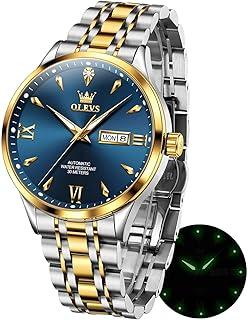 Check Price Check Price |
|
|
|
Diamond Skeleton Tourbillon Luxury Watch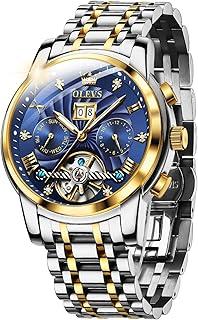 Check Price Check Price |
|
|
|
Thousand Diamond Barrel Luxury Watch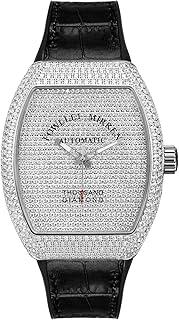 Check Price Check Price |
|
|
|
Skeleton Moon Phase Diamond Watch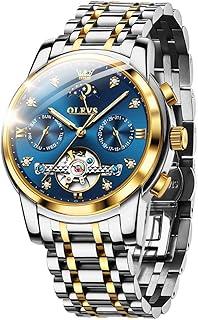 Check Price Check Price |
|
|
|
Moon Phase Tourbillon Chronograph Watch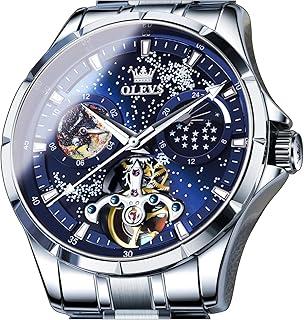 Check Price Check Price |
|
|
|
Starry Sky Multi Calendar Skeleton Watch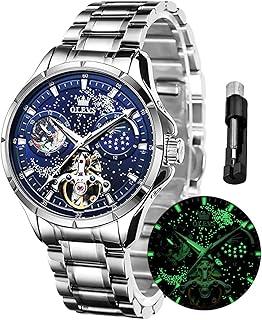 Check Price Check Price |
|
|
|
Skeleton Diamond Luminous Dress Watch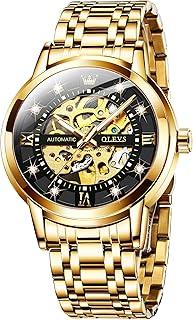 Check Price Check Price |
|
|
|
Triangle Racing Skeleton Watch Check Price Check Price |
|
|
|
Large Face Diamond Women’s Dress Watch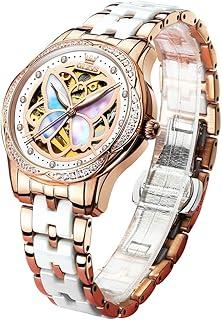 Check Price Check Price |
|
|
|
Recommendations For Best Automatic Watches
Blue Dial Skeleton Tourbillon Dress Watch
The Blue Dial Skeleton Tourbillon Dress Watch combines fashion-forward design with mechanical precision. Its blue dial and skeleton structure expose the intricate inner workings, while the tourbillon feature offers improved accuracy. Perfect for formal occasions, this self-winding watch also displays the date and day.
Features:
- Self-winding mechanical movement
- Skeleton dial design
- Tourbillon feature
- Blue dial
- Date and day display
- Dress watch style
Pros:
- Unique skeleton design
- Tourbillon enhances timekeeping accuracy
- Elegant blue dial
- Automatic movement requires no battery
Cons:
- May be too bold for conservative styles
- Skeleton design may be difficult to read for some
Stainless Steel Luminous Business Watch
The Stainless Steel Luminous Business Watch is crafted for the modern professional. Its self-winding mechanical movement ensures reliable timekeeping, while the stainless steel case and band offer durability. This watch features a calendar display and luminous hands, making it functional and stylish for business settings.
Features:
- Self-winding mechanical movement
- Stainless steel case and band
- Calendar display
- Waterproof design
- Luminous hands
Pros:
- Durable stainless steel construction
- Luminous hands for readability in low light
- Waterproof for daily use
- Classic business design
Cons:
- Lacks advanced features like a tourbillon or skeleton design
- Might feel heavy for some wearers
Diamond Skeleton Tourbillon Luxury Watch
The Diamond Skeleton Tourbillon Luxury Watch is a statement piece designed for those who appreciate intricate craftsmanship and luxury. Its skeleton dial reveals the inner mechanical workings, accented with diamonds, while the tourbillon ensures precise timekeeping. The watch is both waterproof and luminous, making it as functional as it is stylish.
Features:
- Self-winding mechanical movement
- Skeleton dial with diamond accents
- Tourbillon feature
- Luminous hands
- Calendar display
- Waterproof
Pros:
- Eye-catching skeleton design with diamonds
- Tourbillon for enhanced accuracy
- Luminous hands for visibility in the dark
- Luxury look with calendar functionality
Cons:
- Premium pricing due to diamonds
- Skeleton dial may reduce readability
Thousand Diamond Barrel Luxury Watch
The Thousand Diamond Barrel Luxury Watch features a dazzling design with a thousand diamond accents, making it a stunning choice for luxury lovers. Its automatic mechanical movement ensures precision, while the barrel-shaped case offers a distinct look. Waterproof and with an analog display, this unisex watch is perfect for anyone seeking a statement piece.
Features:
- Automatic mechanical movement
- Thousand diamond accents
- Waterproof
- Barrel-shaped case
- Analog display
- Unisex design
Pros:
- Luxurious diamond accents
- Unique barrel case shape
- Waterproof for daily wear
- Unisex design suitable for both men and women
Cons:
- May be overly flashy for some wearers
- High price due to diamond detailing
Skeleton Moon Phase Diamond Watch
The Skeleton Moon Phase Diamond Watch offers a blend of classic luxury and mechanical innovation. With its self-winding movement, moon phase dial, and skeleton design, this timepiece is a visual marvel. The diamond accents and 5-hand configuration make it both functional and eye-catching, perfect for dress occasions.
Features:
- Self-winding mechanical movement
- Moon phase dial
- Skeleton design
- 5-hand configuration
- Diamond accents
- Stainless steel strap
Pros:
- Elegant moon phase complication
- Unique skeleton design
- Diamond accents add luxury
- 5-hand design for added functionality
Cons:
- Complex dial may be overwhelming
- Premium price due to diamonds and moon phase feature
Moon Phase Tourbillon Chronograph Watch
The Moon Phase Tourbillon Chronograph Watch is a powerhouse of features, combining a moon phase display, chronograph, and tourbillon for exceptional functionality. Its self-winding movement ensures accuracy, while the stainless steel case and luminous hands provide durability and readability. Waterproof and elegant, it’s designed for the discerning gentleman.
Features:
- Self-winding mechanical movement
- Moon phase display
- Chronograph function
- Tourbillon feature
- Stainless steel case
- Luminous hands
- Date display
- Waterproof
Pros:
- Moon phase and tourbillon features for enhanced functionality
- Chronograph adds practicality
- Luminous hands for low-light visibility
- Waterproof and durable
Cons:
- Complex dial may be hard to read at a glance
- Higher price due to multiple complications
Starry Sky Multi Calendar Skeleton Watch
The Starry Sky Multi Calendar Skeleton Watch stands out with its celestial-inspired dial and intricate skeleton design. Featuring a self-winding movement, multi-calendar display, and a stainless steel case, this watch blends practicality with artistic elegance. Its waterproof build makes it suitable for daily wear, while the starry sky dial ensures it’s a conversation starter.
Features:
- Self-winding mechanical movement
- Starry sky dial design
- Multi-calendar display
- Skeleton dial
- Stainless steel case
- 5-hand configuration
- Waterproof
Pros:
- Unique starry sky dial
- Multi-calendar functionality
- Eye-catching skeleton design
- Waterproof and durable
Cons:
- Dial may be too busy for some wearers
- Skeleton design may affect readability
Skeleton Diamond Luminous Dress Watch
The Skeleton Diamond Luminous Dress Watch combines luxury and practicality with its skeleton dial, diamond accents, and luminous hands. Designed for both business and formal settings, this self-winding watch is waterproof, making it a versatile accessory for the modern man.
Features:
- Self-winding mechanical movement
- Skeleton dial with diamond accents
- Waterproof
- Luminous hands
- Dress/business style
Pros:
- Stylish skeleton design with diamonds
- Luminous hands for better readability
- Waterproof for everyday use
- Refined business look
Cons:
- Skeleton design might reduce clarity
- High price due to diamond detailing
Triangle Racing Skeleton Watch
The Triangle Racing Skeleton Watch features a bold, racing-inspired triangle dial and golden skeleton design. This mechanical watch has an automatic movement and is waterproof, making it perfect for both casual and dress wear. The leather strap ensures comfort, while the design is sure to stand out in any crowd.
Features:
- Automatic mechanical movement
- Triangle racing-inspired dial
- Golden skeleton design
- Waterproof
- Leather strap
Pros:
- Unique racing-inspired triangle dial
- Golden skeleton design adds elegance
- Waterproof for everyday wear
- Leather strap provides comfort
Cons:
- Triangle dial may be unconventional for some
- Skeleton design could reduce readability
Large Face Diamond Women’s Dress Watch
The Large Face Diamond Women’s Dress Watch offers sophistication and elegance with its diamond-accented large face and durable two-tone stainless steel and ceramic bracelet. This self-winding watch is waterproof, making it a perfect choice for both formal occasions and everyday wear.
Features:
- Self-winding mechanical movement
- Large face with diamond accents
- Two-tone stainless steel and ceramic bracelet
- Waterproof
- Dress style
Pros:
- Elegant large face design
- Diamond accents add luxury
- Durable two-tone bracelet
- Waterproof for daily wear
Cons:
- Large face may not suit smaller wrists
- Premium price due to diamonds and materials
What To Consider When Choosing Automatic Watches
-
Movement Quality:
The heart of an automatic watch is its movement, which can significantly influence its performance and longevity. Automatic movements are categorized into two main types: in-house and outsourced. In-house movements are designed and manufactured by the watch brand itself, reflecting a higher level of craftsmanship and often resulting in a superior product. On the other hand, outsourced movements, while reliable, may not carry the same prestige. Look for reputable movements like ETA, Sellita, or Seiko’s Caliber series, which are known for their durability and precision. -
Brand Heritage:
The brand’s history and reputation play a pivotal role in the value and desirability of an automatic watch. Established brands with a rich heritage, such as Rolex, Omega, and Patek Philippe, not only produce timepieces of exceptional quality but also carry a legacy that can enhance the watch’s value over time. Investigate the brand’s history, craftsmanship, and innovations in horology to understand better what you are purchasing. -
Case Material:
The material used for the watch case significantly impacts both aesthetics and durability. Stainless steel is the most common material due to its strength and resistance to corrosion, making it suitable for everyday wear. Titanium offers a lighter alternative with superior strength, while precious metals like gold and platinum exude luxury and exclusivity. Additionally, consider case finishes—brushed, polished, or a combination thereof—as they contribute to the watch’s overall look and feel. -
Design and Aesthetics:
The design of an automatic watch should resonate with your personal style and lifestyle. From classic, elegant timepieces to sporty, modern designs, the aesthetic appeal is crucial. Pay attention to the dial layout, color scheme, and any unique features such as complications (additional functions beyond telling time). A watch should not only tell time but also express your personality and complement your wardrobe. -
Size and Fit:
The size of the watch case and its overall fit on your wrist is another important factor. Watches come in various sizes, typically measured in millimeters. A larger watch can make a bold statement, while a smaller watch may be more understated and elegant. Consider your wrist size when choosing; ideally, the watch should sit comfortably on your wrist without feeling too tight or loose. Trying on different styles can help you find the perfect fit. -
Complications:
Complications are features in addition to the basic function of telling time. They can range from simple date displays to more complex features like chronographs, moon phases, and perpetual calendars. While complications can add to the watch’s functionality and appeal, they also affect the price and maintenance. Determine what complications you value most based on your lifestyle. For instance, if you often travel, a dual-time zone function may be beneficial. -
Water Resistance:
If you lead an active lifestyle or simply want peace of mind against everyday splashes, consider the watch’s water resistance rating. Measured in meters (or atmospheres), water resistance varies significantly across different models. A watch rated at 30 meters is suitable for everyday wear, while a rating of 100 meters or more is ideal for swimming and snorkeling. Keep in mind that water resistance can diminish over time, especially if the watch has not been serviced regularly. -
Strap and Bracelet Options:
The strap or bracelet is a crucial aspect of an automatic watch, impacting both comfort and style. Options include metal bracelets, leather straps, rubber bands, and fabric NATO straps. Metal bracelets often offer a robust, luxurious feel, while leather straps provide a classic look. Rubber or fabric options are excellent for sporty, casual wear. Consider how the strap complements the watch case and your personal aesthetic. Additionally, interchangeable straps allow for versatility in style and functionality. -
Price and Budget:
Establishing a budget is essential when shopping for an automatic watch. Prices can range from a few hundred dollars to several thousand, depending on brand, materials, and complications. While it can be tempting to stretch your budget for a luxury piece, remember that there are high-quality options available at various price points. Determine what features are non-negotiable for you and where you’re willing to compromise to find the best value. -
Service and Maintenance:
Automatic watches require regular servicing to maintain their accuracy and longevity. Some brands have established service centers, while others may require sending the watch to an authorized dealer. Understand the servicing intervals recommended for the watch you choose, as well as potential costs associated with maintenance. A well-cared-for automatic watch can last a lifetime, making it a worthy investment.
Selecting an automatic watch is a journey that combines personal expression with a deep appreciation for horology. By considering factors such as movement quality, brand heritage, design, fit, and budget, you can make a more informed choice that resonates with your style and lifestyle.
Ultimately, the perfect automatic watch is not just a timekeeping instrument but a reflection of who you are—a piece of art that tells a story, embodies craftsmanship, and stands the test of time. Whether it’s a classic dress watch or a robust sports model, investing in an automatic watch is a decision that goes beyond mere functionality; it becomes a part of your identity and a companion through life’s moments. As you explore the world of automatic watches, remember to enjoy the process, savoring the artistry and craftsmanship that makes each timepiece unique.
Benefits Of Owning Automatic Watches
Automatic watches, also known as self-winding watches, are a marvel of horological engineering, seamlessly combining craftsmanship, functionality, and timeless elegance. Unlike their quartz counterparts, which rely on batteries for power, automatic watches harness the natural motion of the wearer’s wrist to wind their mainspring, enabling them to function perpetually as long as they are worn regularly. Here, we explore the myriad benefits of owning an automatic watch, delving into their craftsmanship, longevity, aesthetic appeal, and the connection they foster between the wearer and the art of watchmaking.
1. Craftsmanship And Heritage
One of the most compelling advantages of automatic watches is their rich heritage and unparalleled craftsmanship. These timepieces often feature intricate movements that showcase the meticulous artistry of skilled watchmakers. Each watch is a symphony of tiny components, including gears, springs, and jewels, all working in harmony to tell time accurately.
Many esteemed watch brands pride themselves on their history, often spanning centuries, which translates into a sense of authenticity and tradition. Owning an automatic watch is akin to possessing a piece of history, where every tick embodies the dedication of generations of artisans who have honed their craft. The craftsmanship involved is not merely functional; it is an art form that speaks to the passion and precision that goes into each timepiece.
2. Longevity And Sustainability
Automatic watches are designed to last. Unlike quartz watches that may require periodic battery replacements, an automatic watch, when properly maintained, can last for decades, if not generations. Their mechanical nature allows for repair and refurbishment, making them far more sustainable than battery-operated alternatives.
Furthermore, the sustainability aspect extends to the materials used in many automatic watches. High-quality steel, gold, and other precious materials are often chosen for their durability and aesthetic appeal. By investing in an automatic watch, you are opting for a product that is likely to withstand the test of time, both in terms of functionality and style.
3. Aesthetic Appeal
The aesthetic allure of automatic watches is undeniable. These timepieces are often characterized by their intricate designs, luxurious finishes, and the stunning display of their mechanical movements through transparent case backs. The craftsmanship involved in creating an automatic watch allows for a variety of styles, from elegant dress watches to rugged dive watches, catering to diverse tastes and occasions.
Additionally, many automatic watches boast features such as luminous hands, chronographs, and intricate complications like perpetual calendars, adding to their visual appeal. Owning an automatic watch is not just about telling time; it’s about wearing a piece of art that enhances your personal style and makes a statement.
4. Connection To The Craft
Owning an automatic watch fosters a unique connection between the wearer and the intricate world of watchmaking. The very nature of these watches invites appreciation for the art of horology. As you wear an automatic watch, you become part of a tradition that values precision, craftsmanship, and innovation.
Every time you check the time, you engage with the watch’s movement, often leading to a deeper appreciation for its engineering marvel. For many enthusiasts, this connection transcends mere functionality, becoming a passion and a form of personal expression.
5. Value Retention And Investment
Automatic watches are not just accessories; they can also be sound investments. Many luxury automatic watches maintain or even increase in value over time, especially limited-edition models or those from prestigious brands. Collectors often seek out specific models, and a well-maintained automatic watch can become a prized possession that appreciates in value.
Investing in an automatic watch is akin to investing in art; the rarity, brand reputation, and condition significantly influence its value in the marketplace. Thus, owning one can be a savvy financial decision as much as a style statement.
6. Self-Winding Convenience
The self-winding mechanism of automatic watches is one of their most significant advantages. This feature means that as long as the watch is worn regularly, it will continue to run without the need for a battery. Even if not worn daily, many automatic watches can be stored in watch winders, ensuring they remain operational and ready to wear. This self-sustaining nature adds to the convenience of ownership, allowing wearers to enjoy their timepiece without the hassle of regular maintenance.
Owning an automatic watch transcends mere timekeeping; it embodies a unique blend of artistry, engineering, and personal expression. The craftsmanship involved in creating these timepieces offers a deep appreciation for the art of horology, while their longevity and sustainability make them a responsible choice for those seeking to invest in quality. The aesthetic appeal of automatic watches, combined with their self-winding convenience, creates a captivating experience for the wearer.
Moreover, the potential for value retention transforms automatic watches from simple accessories into investment pieces that can appreciate over time. As you adorn your wrist with an automatic watch, you are not just telling time; you are embracing a heritage of precision, celebrating craftsmanship, and connecting with the rich history of watchmaking. In a world dominated by digital devices, the allure of an automatic watch serves as a reminder of the beauty of tradition and the enduring legacy of skilled artisans. Whether worn for daily use or special occasions, these exquisite timepieces will always hold a place of honor in the hearts of watch enthusiasts and collectors alike.
Features To Look For In The Best Automatic Watches
When exploring the world of automatic watches, it’s crucial to understand the specific features that distinguish the best timepieces from the rest. Automatic watches, which are powered by the movement of the wearer’s wrist rather than batteries, combine traditional craftsmanship with modern technology. Here’s a detailed exploration of key features to consider when selecting the finest automatic watches:
1. Movement Quality
The heart of any automatic watch is its movement, often referred to as the "caliber." A high-quality movement ensures precision, reliability, and longevity. Swiss movements, such as those produced by brands like ETA or Sellita, are renowned for their craftsmanship and accuracy. Look for watches that feature movements with a high number of jewels (typically 17 to 25), which reduce friction and wear on the components. The level of decoration on the movement, such as Côtes de Genève or perlage finishing, can also indicate quality and aesthetic appeal.
2. Build Material
The materials used in an automatic watch affect its durability, weight, and overall appearance. Stainless steel is the most common material, offering a perfect balance between strength and aesthetics. However, higher-end watches may use precious metals like gold or platinum, while diver’s watches often incorporate titanium for its lightweight and corrosion-resistant properties. Additionally, ceramic bezels and sapphire crystal faces are sought after for their scratch resistance and clarity.
3. Water Resistance
Depending on lifestyle and usage, water resistance can be a critical feature. Most quality automatic watches have a water resistance rating measured in meters (e.g., 30m, 100m, or even 300m). For daily wear, a rating of at least 100m is advisable, especially for those who might swim or shower while wearing the watch. Higher ratings, such as 200m or more, are essential for professional divers, ensuring the watch can withstand significant pressure underwater.
4. Design And Aesthetics
The design of an automatic watch plays a significant role in its appeal. Aesthetics include not only the case design but also the dial layout, color, and the type of markers used. Classic designs, such as the dress watch or pilot’s watch, offer timeless elegance, while sports watches can feature bold colors and rugged builds. Consider the watch’s versatility: can it transition from casual to formal settings? A well-designed watch should reflect personal style while remaining functional.
5. Power Reserve
The power reserve indicates how long an automatic watch will run without additional movement. Most quality automatic watches boast a power reserve ranging from 40 to 80 hours. For example, a watch with an 80-hour power reserve allows the wearer to take it off for an entire weekend without needing to reset the time. Watches with a power reserve indicator feature, showing how much reserve remains, can also be beneficial for managing winding frequency.
6. Complications
Complications refer to any additional features beyond basic timekeeping, such as date displays, chronographs, moon phases, and perpetual calendars. While a simple time-only watch can be elegant, complications add functionality and enhance the watch’s versatility. For instance, a chronograph can serve both as a stopwatch and a stylish element on the wrist. Be mindful of the complexity of the movement, as intricate complications may require more maintenance.
7. Brand Reputation
The brand’s reputation is often a testament to the quality and craftsmanship of their watches. Established brands like Rolex, Omega, and Seiko have built their legacies over decades, ensuring high standards in both watchmaking and customer service. Researching a brand’s history, warranty policies, and after-sales support can provide insight into the value of your investment. Limited editions and collections from reputable brands often retain or even increase their value over time.
8. Bracelet And Strap Options
The comfort and style of a watch are significantly influenced by its strap or bracelet. Automatic watches may come with a variety of options, including metal bracelets, leather straps, and rubber bands. A metal bracelet provides a classic look and durability, while leather offers sophistication and comfort. It’s beneficial to choose a watch with interchangeable straps, allowing for personalization and adaptability to different occasions.
9. Weight And Size
The weight and size of a watch can greatly affect the wearer’s experience. While some prefer the substantial feel of a heavier watch, others may lean towards lightweight models for comfort. Size is also crucial; a watch should fit comfortably on the wrist without being too loose or too tight. Consider the watch’s case diameter and thickness to ensure a proper fit, especially if you have smaller or larger wrists.
10. Warranty And Service
A solid warranty and reliable servicing options are essential for maintaining an automatic watch’s performance over time. A manufacturer’s warranty typically covers defects in materials and workmanship for a specified period. In addition, check if the brand has service centers or authorized dealers in your region, as regular servicing is vital for keeping the movement in optimal condition. A good service plan can extend the life of your watch significantly.
Selecting the best automatic watch is a multifaceted decision that goes beyond mere aesthetics. By understanding and prioritizing features such as movement quality, build material, water resistance, design, power reserve, complications, brand reputation, bracelet options, weight, size, and warranty, you empower yourself to make a well-informed purchase that aligns with your lifestyle and preferences.
The allure of automatic watches lies in their intricate mechanics and the artistry behind their design. These timepieces serve not only as practical tools for timekeeping but also as symbols of craftsmanship and personal expression. Whether you are an avid collector or a first-time buyer, taking the time to evaluate these features will ensure that your investment yields both satisfaction and longevity. As you explore various models and brands, remember that the best automatic watch is one that resonates with your style, meets your functional needs, and becomes a cherished companion on your wrist for years to come.
How To Choose The Right Size
Selecting the right size for an automatic watch is not merely a matter of aesthetics; it significantly impacts comfort, functionality, and the overall wearing experience. Automatic watches, which harness the kinetic energy generated by the wearer’s movement to wind the mainspring, have gained immense popularity due to their craftsmanship and heritage. However, choosing the appropriate size involves understanding several key factors: case diameter, case thickness, lug width, and wrist size.
Understanding Watch Dimensions
1. Case Diameter:
The case diameter, typically measured in millimeters (mm), is perhaps the most crucial measurement when choosing a watch. Watches can range from about 34 mm for smaller, more delicate designs to 50 mm or more for larger, statement pieces.
-
Small Watches (34mm – 38mm): These are often favored by those with smaller wrists or for individuals seeking a more subtle appearance. They offer a vintage aesthetic and are generally easier to wear for longer periods without causing discomfort.
-
Medium Watches (39mm – 42mm): This range has become the most popular, striking a balance between visibility and comfort. Medium watches tend to complement a variety of wrist sizes, making them versatile enough for formal and casual settings alike.
-
Large Watches (43mm and above): These pieces are designed for those who want to make a bold statement. While they can offer more features and legibility, they may be cumbersome for smaller wrists. A larger watch can also shift the visual balance of the wearer’s arm, which may detract from overall elegance.
2. Case Thickness:
While the diameter captures attention, case thickness should not be overlooked. A thicker watch can feel bulkier, regardless of its diameter. Most automatic watches range from 7 mm to 15 mm in thickness.
-
Thin Watches (7mm – 10mm): These are often preferred for dress watches, offering a sleek profile that fits comfortably under shirt cuffs. Their understated design tends to be timeless and classic.
-
Moderate Thickness (11mm – 14mm): This thickness is typical for many sport and casual watches. They balance durability and elegance, making them suitable for everyday wear.
-
Thick Watches (15mm and above): Often found in robust, sportier models, these can provide additional durability and complications but may not be ideal for all-day wear for those with smaller wrists.
3. Lug Width:
Lug width refers to the distance between the lugs, which are the parts of the case that hold the strap or bracelet in place. Lug width can affect how the watch sits on the wrist. A general rule of thumb is that the lug width should not exceed the width of your wrist.
4. Wrist Size:
To choose the right size watch, measuring your wrist is essential. Using a soft measuring tape, wrap it around the wrist just above the wrist bone. This measurement will help determine both the ideal watch size and the appropriate strap length.
-
Small Wrists (under 6.5 inches): Typically suited for watches with a case diameter of 34 mm to 39 mm. A smaller watch will look more proportional and not overpower the wrist.
-
Medium Wrists (6.5 to 7.5 inches): Most versatile, accommodating a variety of sizes. A medium watch in the 39 mm to 42 mm range usually looks best, providing comfort without sacrificing style.
-
Large Wrists (over 7.5 inches): Larger cases from 42 mm to 50 mm are ideal. A larger watch can enhance the wrist’s visual appeal and provide the necessary presence.
Choosing the right size automatic watch is a blend of personal style, wrist dimensions, and functionality. By understanding the critical factors of case diameter, thickness, lug width, and individual wrist size, one can navigate the myriad of options available in the market today. Ultimately, the best automatic watch is one that harmonizes with your lifestyle and personal taste while offering a comfortable and enjoyable wearing experience. Investing in the right watch size ensures that you not only appreciate the watch's aesthetic appeal but also its functionality as a timekeeping instrument. Whether you gravitate toward classic designs, sporty styles, or modern aesthetics, finding the right size is the first step in discovering a piece that you will cherish and wear with pride.
Durability And Performance
Automatic watches are a remarkable testament to the intricate interplay between craftsmanship and technology. These mechanical marvels harness the natural motion of the wearer’s wrist to wind the mainspring, providing a consistent power source that drives the watch’s intricate mechanics. The appeal of automatic watches transcends mere functionality; they are symbols of luxury, heritage, and the artistry of horology.
Durability
The durability of an automatic watch is often a reflection of its construction and the quality of materials used in its design. High-end models frequently feature cases made from stainless steel, titanium, or precious metals, all of which are selected for their resistance to corrosion and wear. Many automatic watches are also designed to withstand significant impacts, thanks to robust cases and carefully engineered movement components.
Furthermore, the crystal that protects the watch face is typically made from either sapphire or mineral glass. Sapphire crystal is particularly valued for its scratch resistance and durability, as it is significantly harder than other materials. This robustness ensures that the watch can endure everyday wear while maintaining its pristine appearance.
Water resistance is another crucial aspect of durability. Many automatic watches are equipped with features that allow them to resist water intrusion to varying depths. This is achieved through tightly sealed cases, reinforced crowns, and gaskets that prevent moisture from entering the delicate inner workings. Models designed for diving, such as the Rolex Submariner or the Omega Seamaster, can often withstand pressures of 300 meters or more, making them suitable for professional underwater activities.
Additionally, the internal components of automatic watches, including the escapement and gear trains, are crafted with precision to reduce friction and wear. Manufacturers often utilize advanced materials like silicon for certain parts, which enhances durability and reduces the need for lubrication. These innovations contribute to the longevity of the watch, allowing it to function accurately for years with minimal maintenance.
Performance
The performance of an automatic watch is closely linked to its precision and reliability. At the heart of any automatic timepiece is the movement, which is responsible for converting energy from the mainspring into regulated timekeeping. The quality of the movement is often indicated by its frequency, measured in vibrations per hour (vph). Higher frequencies typically correlate with greater accuracy. For example, many Swiss movements operate at 28,800 vph, which allows for impressive precision, often within a range of a few seconds per day.
However, the true performance of an automatic watch is not solely determined by its movement specifications. The winding mechanism also plays a vital role. Automatic watches are equipped with a rotor, a semi-circular weight that moves with the wearer’s wrist motion, winding the mainspring as it spins. The efficiency of this mechanism can vary between models, affecting how well the watch maintains its power reserve. High-quality models often feature systems that allow for bi-directional winding, maximizing the energy harvested from movement.
Another performance aspect is the power reserve—the duration for which a fully wound watch can run without additional movement. Many automatic watches boast a power reserve ranging from 40 to 80 hours, with some high-end models offering even longer durations. This feature is particularly advantageous for those who may not wear their watch daily, as it ensures that the timepiece remains operational for extended periods, requiring minimal manual winding.
Furthermore, reputable brands implement rigorous testing standards to ensure that their automatic watches perform under various conditions. Many undergo chronometer certification, which involves a series of tests to evaluate accuracy, reliability, and overall performance. This level of scrutiny assures consumers that they are investing in a timepiece that will stand the test of time, both in terms of durability and precise timekeeping.
Automatic watches epitomize the blend of durability and performance, setting a benchmark in the world of horology. Their robust construction, combined with high-quality materials, ensures they can withstand the rigors of daily life while maintaining aesthetic appeal. The intricate mechanics of the movement showcase the artistry of watchmaking, with precision and reliability at the forefront.
For enthusiasts and collectors alike, owning an automatic watch is not merely about telling time; it is about appreciating the legacy of craftsmanship that has evolved over centuries. As technology continues to advance, these timepieces remain timeless, offering a unique connection to the past while promising performance and durability for the future. Investing in an automatic watch is not just a purchase; it is an embrace of a tradition that marries art and engineering, providing a lasting legacy for generations to come.
How To Care For Your Automatic Watches
Caring for an automatic watch is not merely about maintaining its functionality; it’s also about preserving its beauty and heritage. Automatic watches, often regarded as mechanical masterpieces, require a blend of attentive maintenance and mindful handling. To ensure that your timepiece continues to operate flawlessly and retains its aesthetic appeal, consider the following comprehensive care guidelines.
1. Regular Winding
One of the unique features of automatic watches is their self-winding mechanism, which harnesses the energy from the wearer’s wrist movement. However, if an automatic watch is not worn regularly, it can stop running. To keep it operating smoothly:
- Winding Manually: If you haven’t worn your watch for a few days, it’s advisable to wind it manually. Gently rotate the crown clockwise about 20-30 times to power the mainspring. This ensures that the watch has enough energy to start running.
- Watch Winder: Consider investing in a watch winder. This device mimics wrist movement, keeping your watch wound even when you’re not wearing it. For those with multiple automatic watches, a watch winder with adjustable settings is beneficial, as different models require varying amounts of rotation.
2. Cleaning And Maintenance
Just like any other mechanical device, automatic watches require periodic cleaning to ensure optimal performance. Dust, dirt, and moisture can accumulate over time, potentially harming the intricate components.
- Exterior Cleaning: Use a soft microfiber cloth to wipe the watch case and bracelet regularly. Avoid harsh chemicals; a mix of water and a mild soap can be used for tougher stains. Ensure the watch is water-resistant before using any moisture.
- Crystal Care: The crystal (glass) covering your watch can become scratched or cloudy. Depending on the material (sapphire, mineral, or acrylic), you can polish minor scratches using specific polishing compounds or seek professional help for deeper scratches.
- Professional Servicing: Every 3 to 5 years, take your watch to a certified watchmaker for a complete service. This includes disassembling the watch, cleaning the movement, lubricating parts, and recalibrating it as necessary. Regular servicing prolongs the lifespan of your timepiece and keeps it performing accurately.
3. Avoiding Magnetic Fields
Automatic watches are sensitive to magnetic fields, which can disrupt their delicate movement.
- Keep Away from Electronics: Household electronics such as speakers, mobile phones, and even some kitchen appliances can emit magnetic fields. It’s wise to keep your watch away from these devices to prevent magnetization.
- Demagnetizing Tools: If you suspect your watch has become magnetized, consider using a demagnetizing tool, which can restore it to proper functioning without requiring professional intervention.
4. Water Resistance Precautions
While many automatic watches come with water resistance, it’s essential to understand their limits and care for the seals to maintain this feature.
- Understanding Ratings: Familiarize yourself with the watch’s water resistance rating. Common ratings are 30m (100ft), 50m (165ft), and 100m (330ft). While 30m watches can withstand splashes, only 100m and above can be worn while swimming or snorkeling.
- Seal Maintenance: The rubber gaskets that provide water resistance can degrade over time. Regularly check these seals during servicing, and replace them as necessary to prevent water damage.
5. Proper Storage
How and where you store your automatic watch can significantly affect its longevity.
- Watch Boxes: Store your watch in a dedicated watch box or a soft pouch to protect it from dust and potential scratches. Many watch boxes also come with compartments for multiple timepieces, keeping them organized and safe.
- Avoid Direct Sunlight: Prolonged exposure to sunlight can fade the watch’s dial and degrade the materials used in the strap or bracelet. Store your watch in a cool, dark place to preserve its aesthetics and functionality.
6. Daily Wear Considerations
Automatic watches are designed to be worn daily, but mindful wearing can prevent unnecessary wear and tear.
- Rotation: If you have multiple watches, rotate them regularly. This practice prevents one watch from becoming overly worn while allowing others to be enjoyed.
- Watch Accessories: Consider using a soft, padded watch roll for travel. This provides cushioning against impact and helps to avoid scratches.
Caring for your automatic watch is not just a routine task; it is a labor of love that reflects your appreciation for craftsmanship and timeless elegance. Each aspect of care—from regular winding to thoughtful storage—ensures that your watch remains a reliable companion through the years, serving both functional and aesthetic purposes.
By following these guidelines, you not only enhance the longevity of your automatic timepiece but also preserve the memories and moments it signifies. Remember, every watch tells a story, and with the right care, your automatic watch can continue to narrate its tale for generations to come. Embrace the artistry of your timepiece, and treat it with the respect it deserves, transforming the act of watch maintenance into a ritual of connection with a cherished possession.
Comparing Automatic Watches With Alternatives
When it comes to wristwatches, the choices are abundant, but few have the charm and craftsmanship of automatic watches. These timepieces, which utilize the natural motion of the wearer’s wrist to wind their mainspring, often draw enthusiasts with their intricate mechanics and artistry. However, to fully appreciate the allure of automatic watches, it’s essential to compare them with alternatives such as quartz watches, smartwatches, and hybrid models. Each type brings its unique advantages and disadvantages, appealing to different segments of watch enthusiasts and casual wearers alike.
Automatic Watches
Automatic watches, also known as self-winding watches, are revered for their engineering and heritage. The heart of an automatic watch is its movement, a complex assembly of gears, springs, and levers that work in concert to measure time. The fundamental appeal of these watches lies in their traditional craftsmanship and mechanical nature. Watchmakers spend years honing their skills, meticulously assembling movements that can consist of hundreds of tiny components.
Pros
- Craftsmanship and Heritage: Many collectors appreciate the artistry involved in creating automatic watches. The meticulous craftsmanship often reflects generations of watchmaking tradition, leading to watches that can be considered works of art.
- No Battery Required: Automatic watches do not require battery changes. They are powered by the kinetic energy generated from the wearer’s wrist movements, making them environmentally friendly and low-maintenance in this respect.
- Smooth Movement: The sweeping second hand of an automatic watch, which glides rather than ticks, is often considered more aesthetically pleasing. This smooth motion is a hallmark of high-quality mechanical engineering.
- Longevity: With proper care, an automatic watch can last for generations. Many collectors find joy in passing down their timepieces to future generations.
Cons
- Accuracy: While many automatic watches are highly accurate, they generally do not keep time as precisely as quartz watches. They can be affected by factors like temperature and position, leading to slight variations.
- Maintenance: Automatic watches require regular servicing every few years to ensure longevity and accuracy, which can be costly.
- Power Reserve Limitations: If not worn regularly, an automatic watch can stop running due to a lack of winding. This necessitates manual winding or use of a watch winder, which can be an added expense.
Quartz Watches
In contrast to the intricate mechanics of automatic watches, quartz watches utilize a battery-powered movement that relies on the vibrations of a quartz crystal to keep time. First introduced in the late 1960s, quartz technology revolutionized the watch industry by offering unparalleled accuracy and affordability.
Pros
- Accuracy: Quartz watches are known for their precision. They typically deviate by only a few seconds per month, making them ideal for users who prioritize timekeeping accuracy.
- Low Maintenance: With fewer moving parts and no need for regular servicing, quartz watches are much easier to maintain. The primary maintenance task is changing the battery every couple of years.
- Affordability: Generally, quartz watches are less expensive than their automatic counterparts. This makes them accessible to a broader audience and often leads to more options within a given budget.
Cons
- Battery Dependency: The need for battery replacement can be seen as a drawback. While it’s a straightforward process, it adds an element of ongoing care that some users prefer to avoid.
- Less Craftsmanship Appeal: For many watch enthusiasts, quartz watches lack the artisanal craftsmanship and emotional connection that comes with mechanical timepieces.
- Less Aesthetic Appeal: The ticking second hand of a quartz watch is often perceived as less elegant than the sweeping hand of an automatic watch.
Smartwatches
In recent years, smartwatches have entered the market, blending technology with traditional watch functionality. They offer features beyond timekeeping, including fitness tracking, notifications, and app integration, appealing to tech-savvy consumers.
Pros
- Versatility: Smartwatches can serve multiple purposes, functioning as fitness trackers, communication devices, and media players, making them versatile companions for modern life.
- Customization: Users can often change watch faces, notifications, and even apps, allowing for a personalized experience.
- Fitness and Health Tracking: Many smartwatches offer advanced health metrics, including heart rate monitoring, GPS tracking, and sleep analysis, catering to fitness enthusiasts.
Cons
- Battery Life: Smartwatches typically require frequent charging, often daily or every few days, which can be inconvenient for users accustomed to the convenience of a traditional watch.
- Less Heritage and Craftsmanship: While innovative, smartwatches lack the traditional craftsmanship and emotional connection found in mechanical watches.
- Dependency on Technology: As technology evolves, smartwatches may become obsolete faster than traditional watches, which can last a lifetime.
Hybrid Watches
Combining elements of both mechanical and digital technology, hybrid watches are a growing segment. They often feature traditional watch aesthetics with smart technology integrated into the design.
Pros
- Best of Both Worlds: Hybrid watches typically offer a classic appearance with added smart features, such as notifications or fitness tracking, appealing to those who want style and functionality.
- Longer Battery Life: Unlike full smartwatches, many hybrid models boast extended battery life, often lasting several months on a single charge.
Cons
- Limited Smart Features: While hybrids offer some technology, they often don’t have the full range of capabilities found in smartwatches.
- Potentially Higher Cost: The combination of mechanical and digital technology can make hybrid watches more expensive than traditional quartz options.
Choosing between automatic watches and their alternatives—quartz, smartwatches, or hybrids—ultimately comes down to personal preference, lifestyle, and what one values in a timepiece. Automatic watches resonate with collectors and enthusiasts who appreciate craftsmanship, tradition, and the artistry of horology. Their intricate mechanics and timeless design often create a deeper emotional connection with their owners, making them more than just a tool for telling time. On the other hand, quartz watches offer unmatched accuracy and low maintenance, appealing to those who prioritize functionality and cost-effectiveness. Smartwatches cater to the modern user, blending technology and versatility, while hybrid models provide a middle ground, balancing tradition with contemporary features. In an era where timepieces have transcended mere utility to become reflections of personal identity, the decision ultimately lies in the individual’s values and lifestyle. Whether it’s the heart-pounding thrill of a self-winding movement or the effortless efficiency of a digital interface, there’s a watch to suit every wrist and story to tell through each tick of the second hand. The world of horology is rich and diverse, inviting enthusiasts and casual wearers alike to explore, appreciate, and ultimately choose the timepiece that resonates most with them.
Style And Design Trends For Automatic Watches
Automatic watches have long been revered not just for their intricate mechanics but also for their aesthetic appeal. As we progress through the 21st century, the landscape of watch design continues to evolve, reflecting contemporary tastes while paying homage to timeless craftsmanship. Here are some of the key style and design trends shaping the world of automatic watches today.
Minimalism Meets Functionality
One of the most significant trends in recent years is the shift toward minimalist design. Brands are increasingly favoring simplicity over complexity, focusing on clean lines, uncluttered dials, and understated elegance. This trend aligns with a broader movement in consumer culture that values functionality and practicality over ostentation.
Minimalist automatic watches typically feature a muted color palette, often dominated by blacks, whites, and metallics. Dials are often devoid of excessive markings, relying instead on subtle textures or materials to create visual interest. Brands like Nomos Glashütte have embraced this ethos, producing watches that embody the ‘less is more’ philosophy while maintaining a high level of craftsmanship and precision.
Vintage Revivals
Alongside the minimalist movement, a nostalgic appreciation for vintage aesthetics is gaining traction. Many modern watchmakers are drawing inspiration from designs that date back several decades, reviving iconic styles and reinterpretations of classic timepieces. This trend is particularly prevalent in the realm of dive watches and pilot watches, where designs often evoke a sense of adventure and ruggedness.
The allure of vintage automatic watches lies not just in their design but also in the stories they tell. Brands like Tudor and Longines have tapped into this nostalgia by releasing reissued models that maintain the spirit of the originals while integrating modern technology and reliability. This revival of classic styles resonates with consumers who appreciate the history and heritage associated with these timepieces.
Sustainable Practices And Materials
As awareness of environmental issues grows, so too does the demand for sustainable practices in the luxury watch industry. Consumers are increasingly seeking watches that reflect their values, leading brands to adopt eco-friendly materials and ethical sourcing methods. From recycled metals to vegan leather straps, the push for sustainability is transforming the materials used in automatic watch design.
Brands like Swatch and TAG Heuer have begun to incorporate innovative materials such as bio-based plastics and recycled ocean plastics into their designs. Additionally, the rise of the circular economy is influencing how watches are produced, encouraging companies to implement recycling programs and reduce waste. This trend not only appeals to eco-conscious consumers but also fosters a sense of responsibility within the industry.
Technological Integration
The convergence of traditional watchmaking and modern technology is another defining trend. While automatic watches are celebrated for their mechanical movements, many brands are now exploring ways to integrate smart technology without compromising the aesthetic appeal of the timepiece. Hybrid watches, which combine automatic mechanics with smart functionalities, are becoming increasingly popular.
For instance, brands like Montblanc and Garmin are pioneering hybrid designs that offer the best of both worlds: the timeless elegance of a mechanical watch coupled with features such as fitness tracking, notifications, and GPS capabilities. This trend caters to a tech-savvy audience that appreciates the craftsmanship of traditional watches while also desiring the convenience of modern technology.
Customization And Personalization
In an era where individuality is celebrated, the demand for customizable automatic watches is on the rise. Consumers are increasingly seeking timepieces that reflect their personal style and preferences. Brands are responding to this trend by offering customizable options, allowing customers to select everything from dial colors and materials to strap styles.
This trend is exemplified by companies like Bamford Watch Department, which specializes in personalized luxury watches. By allowing clients to modify and customize existing designs, brands are fostering a deeper connection between the consumer and the product. Personalization not only enhances the emotional value of the watch but also aligns with a growing desire for unique, one-of-a-kind pieces.
Conclusion
As we look to the future of automatic watches, it’s clear that the industry is poised for continued evolution. The intersection of tradition and innovation is creating an exciting landscape where style and functionality coexist harmoniously. Whether through minimalist designs, vintage revivals, sustainable practices, technological integration, or personalized options, automatic watches are not only a testament to exceptional craftsmanship but also a reflection of modern consumer values.
In this dynamic world, automatic watches remain more than mere timekeeping devices; they are expressions of individuality, heritage, and a commitment to quality. As trends continue to shift, one thing remains certain: the allure of the automatic watch will endure, captivating new generations of enthusiasts and collectors alike.
FAQs
What Is An Automatic Watch?
An automatic watch, also known as a self-winding watch, is a type of mechanical timepiece that winds itself as long as it is worn. It utilizes the natural motion of the wearer’s wrist to power the movement, using a rotor that spins with movement to wind the mainspring.
How Does An Automatic Watch Work?
Automatic watches operate through a complex mechanism of gears and springs. The rotor, a semi-circular piece connected to the movement, rotates with the motion of the wrist. This rotation winds the mainspring, which stores energy and powers the watch. When not worn, the watch may stop, but it can be manually wound if needed.
What Are The Advantages Of Automatic Watches?
The advantages of automatic watches include convenience, as they do not require battery replacements; craftsmanship, as they often feature intricate mechanical designs; and longevity, as they can last for generations with proper care. Additionally, they are environmentally friendly since they do not rely on batteries.
How Do I Maintain An Automatic Watch?
To maintain an automatic watch, it’s essential to regularly service it, typically every 3 to 5 years, depending on the model and usage. Keep it clean and avoid exposure to extreme temperatures or magnetic fields. Wearing it regularly will keep it wound, but if not worn for an extended period, consider using a watch winder to maintain the movement.
Can Automatic Watches Be Worn While Swimming?
Whether an automatic watch can be worn while swimming depends on its water resistance rating. Most automatic watches are not designed for prolonged exposure to water unless specifically rated as water-resistant. Check the manufacturer’s specifications to ensure that the watch can withstand water exposure.
What Is The Difference Between Automatic And Quartz Watches?
The primary difference between automatic and quartz watches lies in their movements. Automatic watches are powered by mechanical movement and require winding, while quartz watches are battery-powered and use a quartz crystal for precise timekeeping. Quartz watches generally offer greater accuracy, while automatic watches appeal to enthusiasts for their craftsmanship.
Are Automatic Watches Accurate?
Automatic watches can be very accurate, but their precision typically ranges from -20 to +20 seconds per day, depending on the quality of the movement. High-end models often have tighter tolerances and can achieve chronometer certification, which indicates exceptional accuracy within a specified range.
What Should I Do If My Automatic Watch Stops?
If your automatic watch stops, it may need to be wound manually if it hasn’t been worn for some time. Simply unscrew the crown and wind it clockwise. If the watch still doesn’t work, it may require professional servicing to address potential mechanical issues.
What Materials Are Commonly Used In Automatic Watches?
Automatic watches are made from a variety of materials, including stainless steel, gold, titanium, and ceramics for the case and band. The movement components are often crafted from metals like brass or stainless steel. Sapphire crystal is commonly used for the watch face due to its scratch resistance.
Can Automatic Watches Be Found At Different Price Points?
Yes, automatic watches are available at a wide range of price points. Entry-level models can be found for a few hundred dollars, while luxury brands may offer watches that cost thousands or even tens of thousands of dollars. The price often reflects the craftsmanship, brand reputation, and materials used.
